Overview:
The article provides a step-by-step guide on using an A1C calculator for effective blood sugar management, emphasizing its importance in monitoring diabetes. It supports this by detailing the process of gathering blood sugar data, accessing a reliable calculator, and interpreting results, highlighting how regular A1C testing can lead to informed treatment decisions and improved health outcomes.
Introduction
The A1C test is a cornerstone of diabetes management, offering vital insights into an individual’s average blood sugar levels over the past two to three months. This simple yet powerful measure not only aids in assessing diabetes control but also plays a crucial role in preventing potential complications associated with the condition.
As the prevalence of prediabetes rises—affecting millions across various demographics—understanding the implications of A1C results becomes increasingly important. This article delves into the significance of the A1C test, providing a comprehensive guide on its functionality, interpretation, and strategies for maintaining optimal levels.
With a focus on practical steps and informed decision-making, readers will gain essential knowledge to navigate their diabetes journey effectively.
Understanding the A1C Test: Importance and Functionality
Introducing T2DSolutions: your all-encompassing resource for Type 2 and Type 3 blood sugar control. As a new site by the T2DSolutions Content Team, we are excited to soon provide valuable content and resources to support your health journey. The A1C calculator blood sugar serves as a critical measure of diabetes management by quantifying the percentage of hemoglobin in the blood that has become glycated, or coated with sugar.
This test is particularly significant as it reflects average blood sugar concentrations over the preceding two to three months, correlating with the life cycle of red blood cells, which regenerate approximately every three months. Elevated A1C readings indicate insufficient blood sugar control, potentially resulting in severe complications. Regular A1C testing is essential, as it enables patients and healthcare providers to make informed decisions regarding treatment plans and necessary lifestyle modifications, particularly through the use of an A1C calculator blood sugar.
As T2DSolutions launches, we recognize the urgency of proactive monitoring, especially given that recent statistics reveal a concerning trend:
- 41.0% of men
- 32.0% of women
have been identified as having prediabetes based on their fasting glucose or A1C levels.
Alarmingly, an estimated 15.0 million Hispanic adults had prediabetes in 2021, with a prevalence rate of 34.5% and only 20.9% awareness of their condition. This underscores the importance of our hub in providing education and support across diverse populations. Furthermore, the economic burden of this condition continues to rise, with estimated direct and indirect costs totaling $413 billion in the United States in 2022.
The direct medical expenses per person impacted by the condition rose from $10,179 in 2012 to $12,022 in 2022, indicating a significant increase in financial strain. This includes a rise in direct costs from $227 billion to $307 billion and indirect costs from $89 billion to $106 billion over the same period. As mentioned by Balintescu A., the A1C calculator blood sugar test offers essential insights in the realm of blood sugar control in intensive care, directing improved health results.
Thus, regular monitoring of A1C values with an A1C calculator blood sugar is not merely a routine check; it is a fundamental component of effective diabetes management that can significantly impact patient outcomes. We invite you to subscribe for updates to stay informed about our upcoming resources and support from the T2DSolutions Content Team.
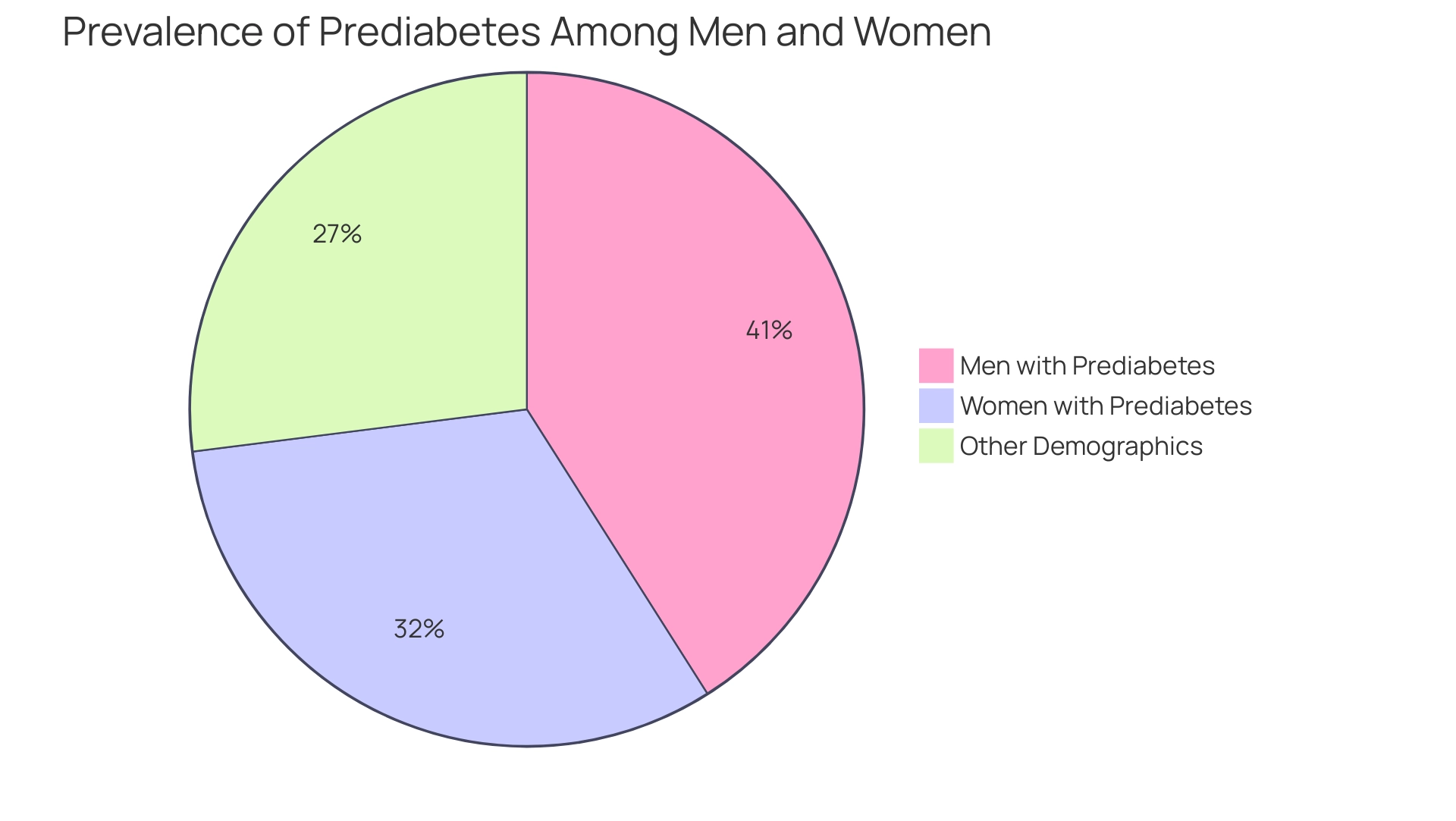
Step-by-Step Guide to Using an A1C Calculator for Blood Sugar Management
-
Gather Your Data: Begin by collecting your recent blood sugar readings, which should include both fasting and post-meal measurements. If available, it is also beneficial to include your previous A1C results for context. Monitoring these levels is crucial, especially as studies show that 93.0% of individuals had their cholesterol checked, highlighting the importance of regular health assessments. At T2 Solutions, we are dedicated to empowering newly diagnosed individuals with the resources they require for effective condition oversight, including educational materials and tailored assistance.
-
Access an A1C Calculator: Navigate to a trustworthy online A1C calculator or download a mobile app specifically created for health monitoring to ensure you are using a tool that provides accurate estimations. T2DSolutions will showcase selected tools and resources, including easy-to-use calculators and access to webinars on health control.
-
Input Your Blood Sugar Readings: Carefully enter your blood sugar readings into the calculator. Precision is vital, so double-check the values to avoid discrepancies in your results.
-
Calculate Your A1C: After inputting your data, click the calculate button on the A1C calculator to generate your estimated A1C percentage based on the information provided.
-
Review the Results: Examine the A1C percentage generated by the calculator, along with any additional insights or recommendations offered. Heather Davis, a Registered and Licensed Dietitian Nutritionist, emphasizes, "Discussing these results with a healthcare professional is vital for tailored advice and action steps." Furthermore, given the widespread occurrence of prediabetes, affecting approximately 97.6 million U.S. adults, it is crucial to be proactive in tracking your A1C values and seeking advice from healthcare professionals for effective management of the condition. T2DSolutions is here to support you with valuable insights, community forums, and resources as you navigate your health journey.
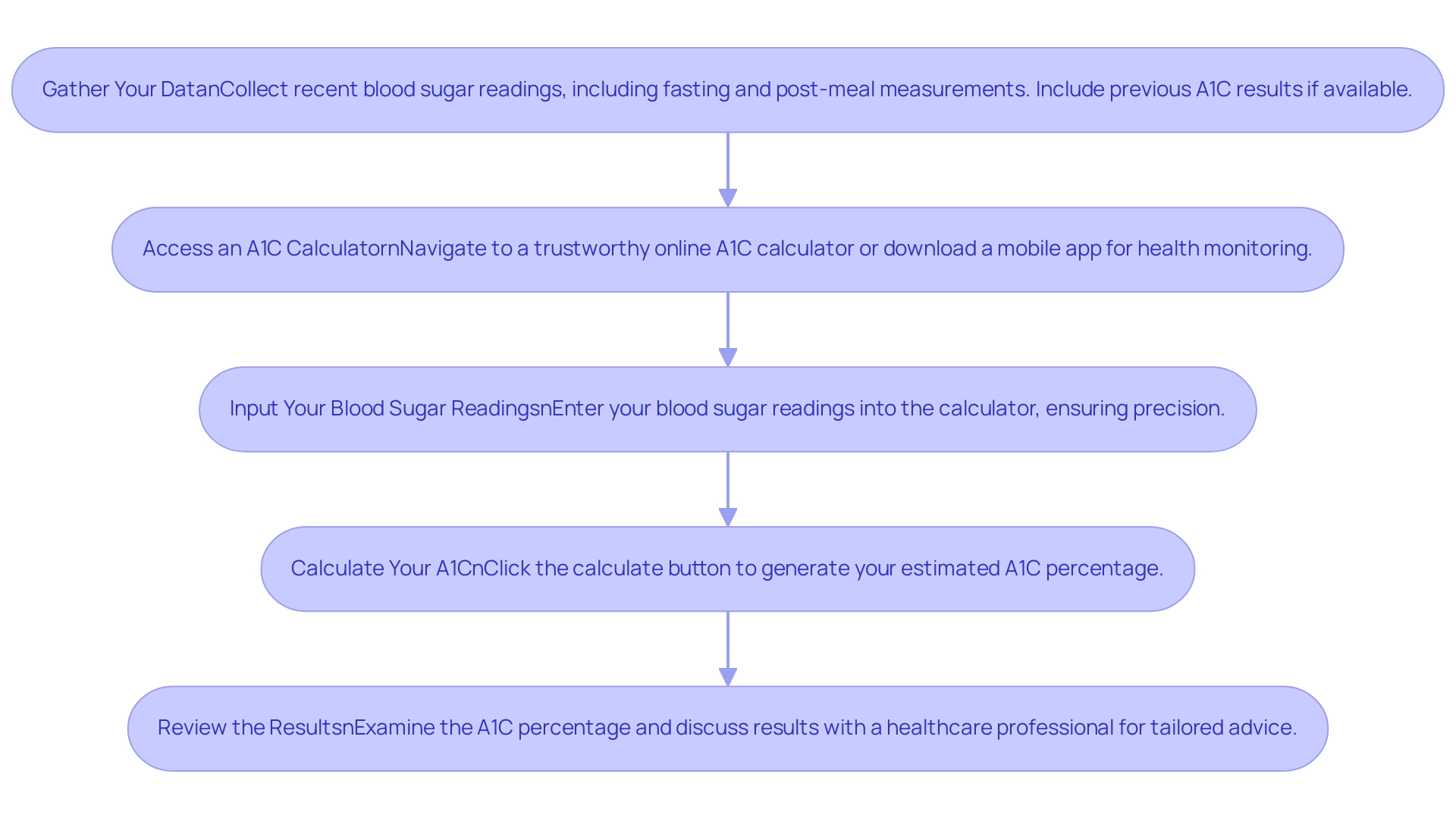
Interpreting Your A1C Results: What Do They Mean for Your Health?
A1C results are categorized into distinct ranges that define an individual's glycemic status:
- Normal: Less than 5.7%
- Prediabetes: 5.7% to 6.4%
- Diabetes: 6.5% or higher.
For individuals diagnosed with this condition, the typically suggested target A1C measurement is below 7%. However, this target can be adjusted based on individual health conditions and risk factors.
Elevated A1C levels are associated with an increased risk of diabetes-related complications, including cardiovascular disease and neuropathy. Recent findings highlight that over 15% of individuals with HIV may present with prediabetes, underscoring the need for regular monitoring. As part of Td Solutions, it is essential to consult your healthcare provider to accurately interpret your A1C results using an A1C calculator blood sugar and discuss their implications for your treatment plan and necessary lifestyle modifications.
Our platform seeks to offer extensive resources and assistance for newly diagnosed patients, including educational materials and personalized guidance to help you comprehend your A1C results with an A1C calculator blood sugar and manage your condition effectively. We highlight the significance of ongoing screening for prediabetes and type 2 conditions, particularly for individuals at risk. Furthermore, the evolving classification schemes for this condition that focus on β-cell dysfunction may influence how A1C results are interpreted in the future.
The case study titled 'Antihyperglycemic Agents in PTDM' illustrates the need for well-designed trials to assess the efficacy and safety of various antihyperglycemic agents in individuals with high blood sugar, providing real-world context for treatment considerations. Thus, comprehending A1C results with an A1C calculator blood sugar is essential for effective control and preventing future health hazards.
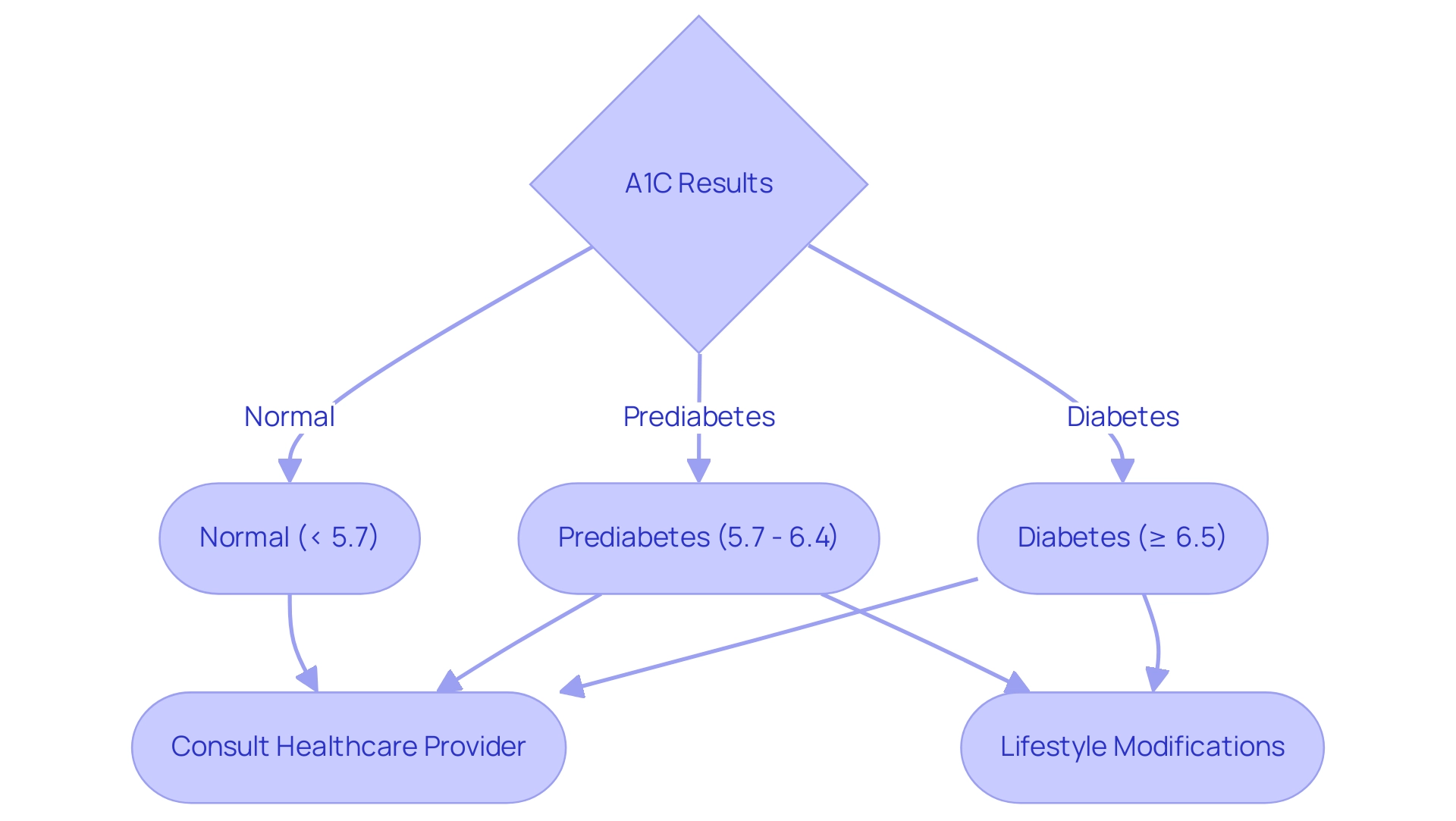
Connecting A1C Levels to Average Blood Glucose: A Comprehensive Overview
Introducing T2DSolutions: Your comprehensive resource for Type 2 and Type 3 blood sugar management. As a new hub for diabetes education and community support, T2DSolutions aims to empower newly diagnosed patients with essential knowledge and tools. The A1C calculator blood sugar test serves as an essential tool, providing an estimate of average blood glucose readings over the prior two to three months.
To convert A1C percentages to estimated average glucose (eAG), the following formula is utilized:
- eAG (mg/dL) = (A1C × 28.7) - 46.7
For instance, an A1C of 7% translates to an average blood glucose level of approximately 154 mg/dL. This relationship is crucial for individuals managing their condition, as it allows them to utilize an A1C calculator blood sugar to assess their daily blood sugar control and make informed adjustments to their treatment plans. Recent studies, including those from the Diabetes Control and Complications Trial, have demonstrated the importance of maintaining optimal A1C levels to prevent complications associated with this condition.
Furthermore, the case study titled "Outlook on Prediabetes" emphasizes that prediabetes frequently progresses to a more severe condition without noticeable symptoms, making regular blood glucose checks essential, particularly for individuals over 45 or with a family history of the illness. Healthy lifestyle practices, such as physical activity and weight control, can assist in preventing the advancement from prediabetes to type 2, emphasizing the significance of comprehending A1C and eAG conversions, and utilizing an A1C calculator blood sugar. Furthermore, specialists such as Dr. Alana Biggers highlight the link between blood sugar control and overall wellness, stating,
Type 2 condition can impact your oral health.
This highlights the importance of proper blood sugar regulation not only for addressing glucose-related health issues but also for preserving oral health.
Stay informed with T2D Solutions by signing up for emails on new content as we expand our resources for your health journey.
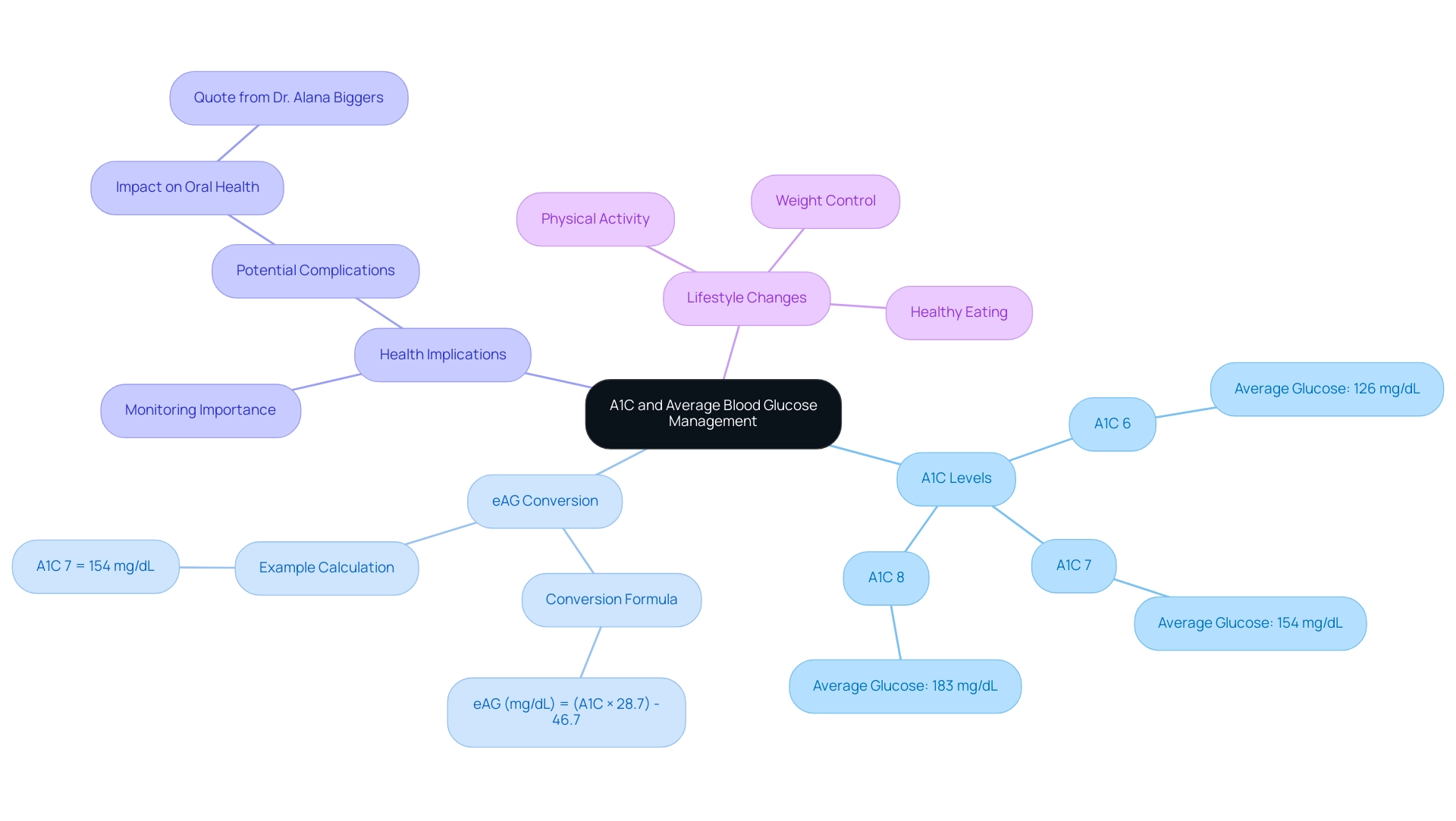
Strategies for Lowering A1C Levels: Tips for Better Blood Sugar Control
Welcome to T2DSolutions, your comprehensive resource for Type 2 and Type 3 diabetes management. As you embark on this journey, maintaining a balanced diet is crucial. Prioritize whole foods, focusing on a variety of vegetables, lean proteins, and whole grains.
Research indicates that a diet rich in these components can significantly affect A1C values, which can be tracked using an a1c calculator blood sugar. For instance, participants in a recent study reported a fiber intake increase from 14.9 g/day at baseline to 17.2 g/day after 12 months, showcasing the positive effects of dietary modifications. Additionally, a study titled 'T2D Risk and HbA1c According to Joint Categories of the Diet Quality Score and the GRS' found that individuals with a higher Genetic Risk Score (GRS) had an increased risk of Type 2 Diabetes, particularly when their diet quality was low.
Limiting processed foods and sugars is crucial, as these can lead to spikes in blood glucose levels.
-
Monitor Blood Sugar Regularly: Keeping a consistent log of your blood glucose readings is essential for understanding how various factors affect them. Regular monitoring helps identify patterns that can inform dietary choices and lifestyle adjustments, enabling more effective management of diabetes.
-
Engage in Regular Physical Activity: Aim for at least 150 minutes of moderate exercise each week, such as brisk walking or cycling. Consistent physical activity has been demonstrated to reduce blood sugar rates and enhance insulin sensitivity. However, it is noteworthy that approximately 31.9% of individuals were found to be physically inactive, engaging in less than 10 minutes of moderate or vigorous activity weekly. Raising this activity intensity is essential for improved blood sugar control.
-
Adhere to Medication Regimens: It is paramount to follow your healthcare provider's instructions concerning any prescribed diabetes medications or insulin. Following medication regimens, along with dietary and lifestyle adjustments, can significantly enhance A1C outcomes, which can be monitored using an a1c calculator blood sugar over time.
-
Manage Stress: Chronic stress can adversely impact blood sugar rates, making it essential to incorporate stress-reducing techniques into your daily routine. Practices such as mindfulness, yoga, or deep breathing exercises can help mitigate stress and support overall wellbeing. As noted in the Health Professionals Follow-Up Study (HPFS), the possible mechanisms explaining the influence of stress may include the moderating effects of sex hormones on glucose and lipid metabolism.
-
Stay Hydrated: Proper hydration is crucial, as dehydration can lead to elevated blood sugar levels. Consuming ample water during the day aids in sustaining ideal hydration and can assist in effective blood sugar control.
At T2DSolutions, we are dedicated to offering you tools and resources, such as an A1C calculator blood sugar, to aid your journey in handling diabetes-related concerns. Don't forget to subscribe to our updates to stay informed about new content and resources that can help you in managing your condition effectively. Stay tuned for more resources and support as we continue to grow and provide valuable information for your diabetes management journey.
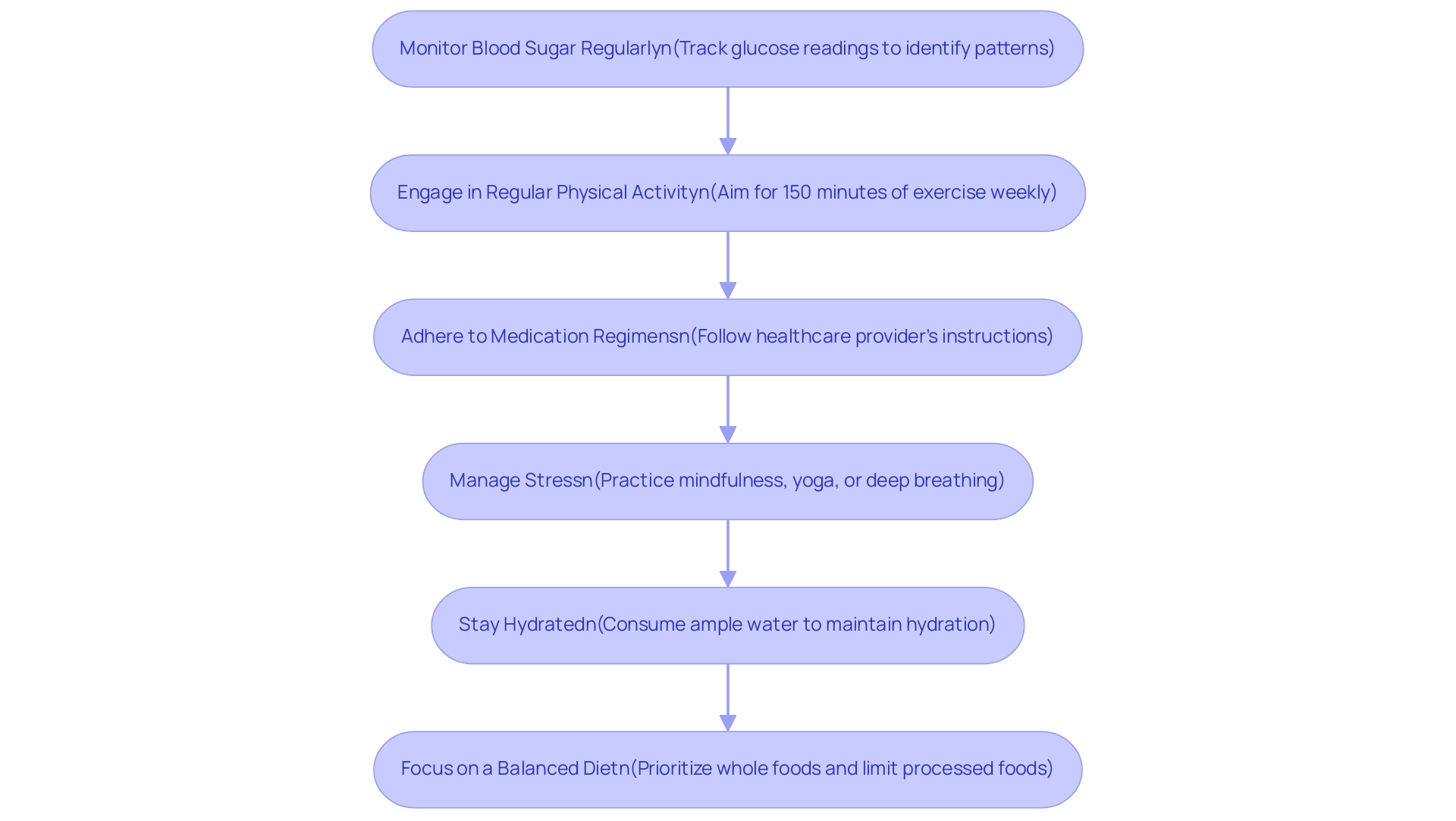
Conclusion
The A1C test plays a pivotal role in diabetes management by providing essential insights into an individual's average blood sugar levels over the past two to three months. Understanding this test is crucial, particularly as the incidence of prediabetes continues to rise, affecting millions. Regular monitoring of A1C levels is not just a routine procedure; it is a fundamental practice that empowers individuals to make informed decisions regarding their health, helping to prevent potential complications associated with diabetes.
By utilizing tools like A1C calculators and interpreting results accurately, individuals can gain a clearer picture of their glycemic status and adjust their treatment plans accordingly. This proactive approach to diabetes management encourages lifestyle changes, such as:
- Maintaining a balanced diet
- Engaging in regular physical activity
- Managing stress levels
All of which contribute to lowering A1C levels and improving overall health.
As the landscape of diabetes management evolves, the importance of understanding A1C results and their implications cannot be overstated. With the right resources and support, individuals can navigate their diabetes journey more effectively, ultimately leading to better health outcomes. Staying informed and proactive is key to managing diabetes and fostering a healthier future.



